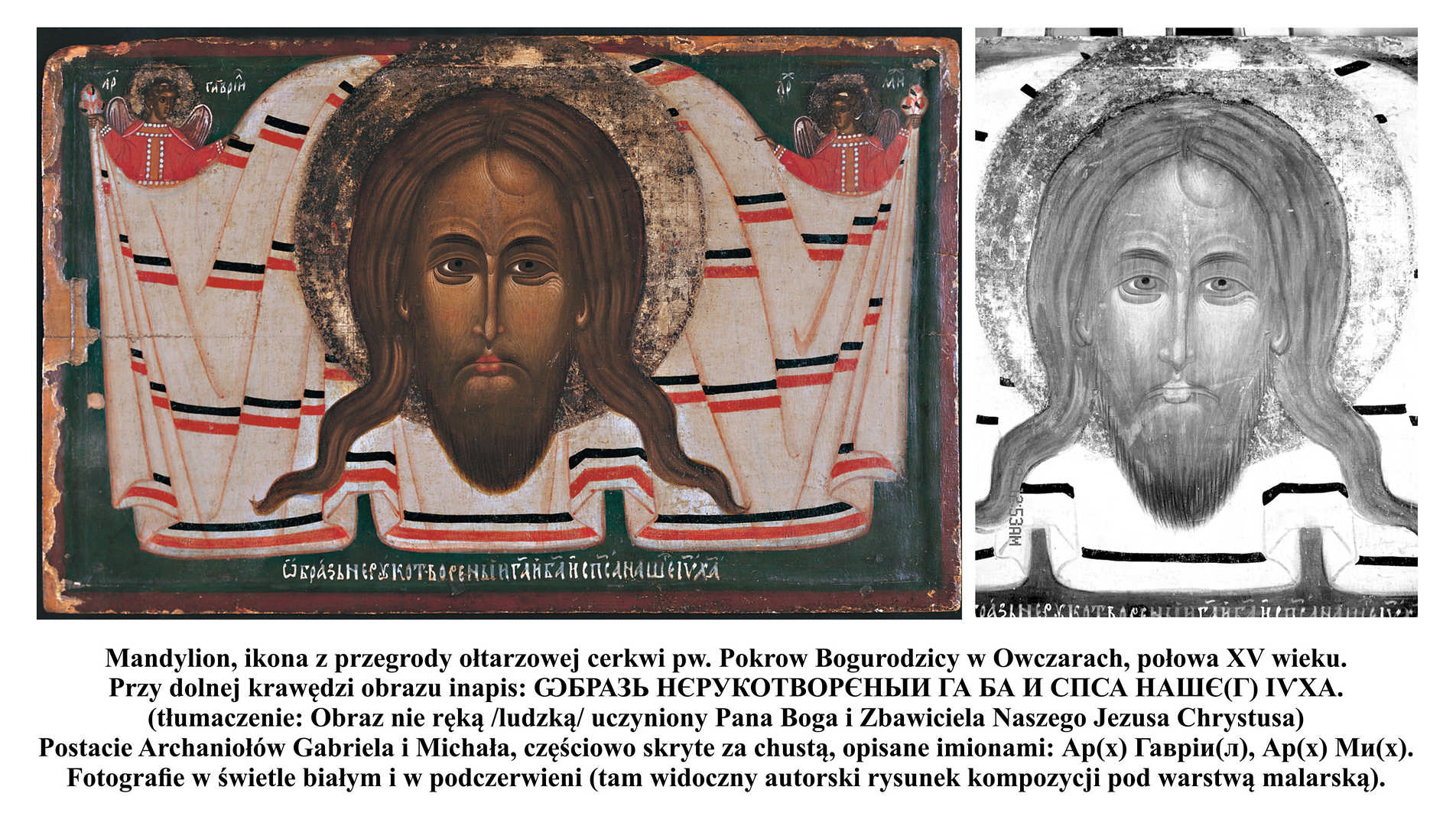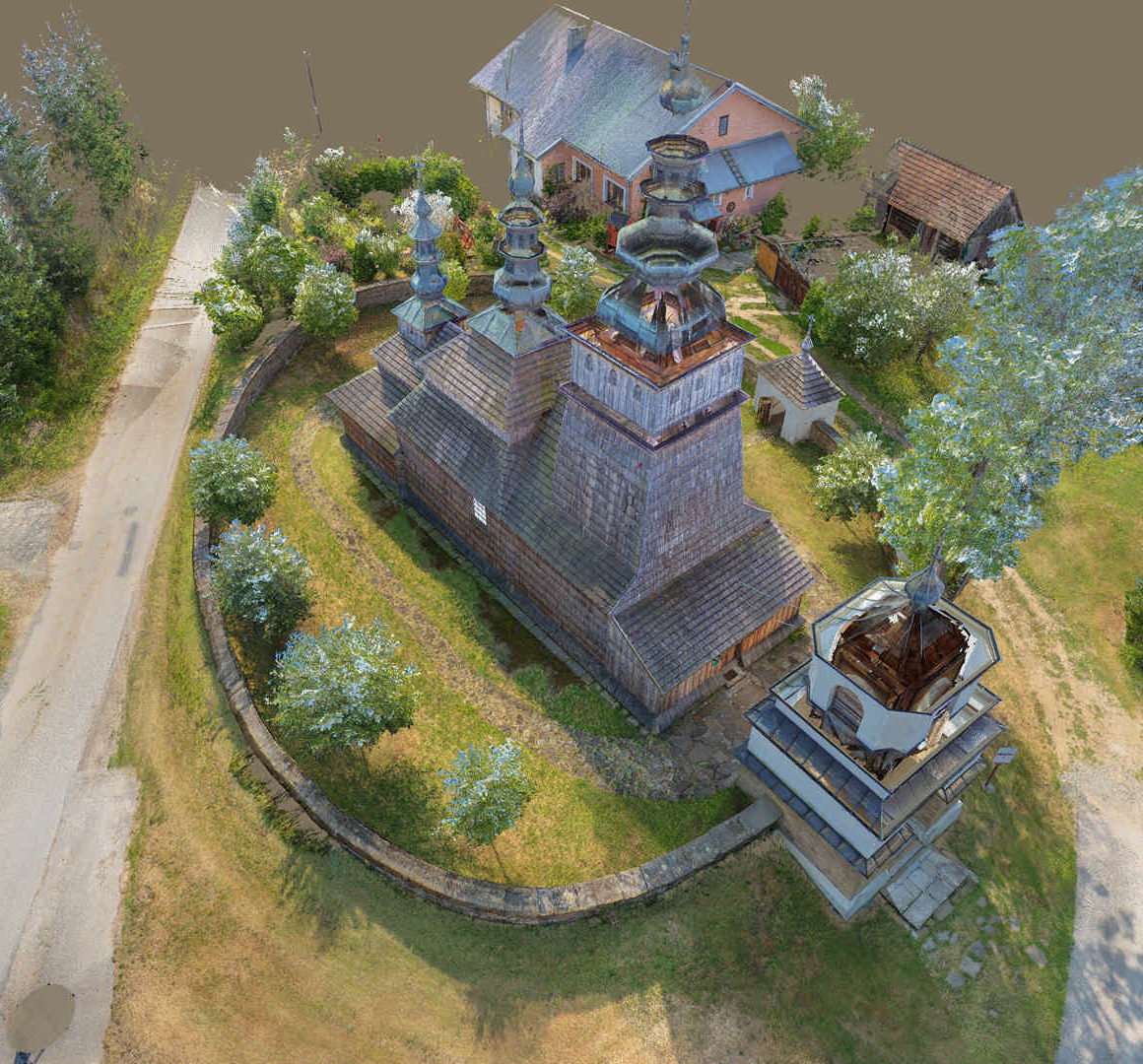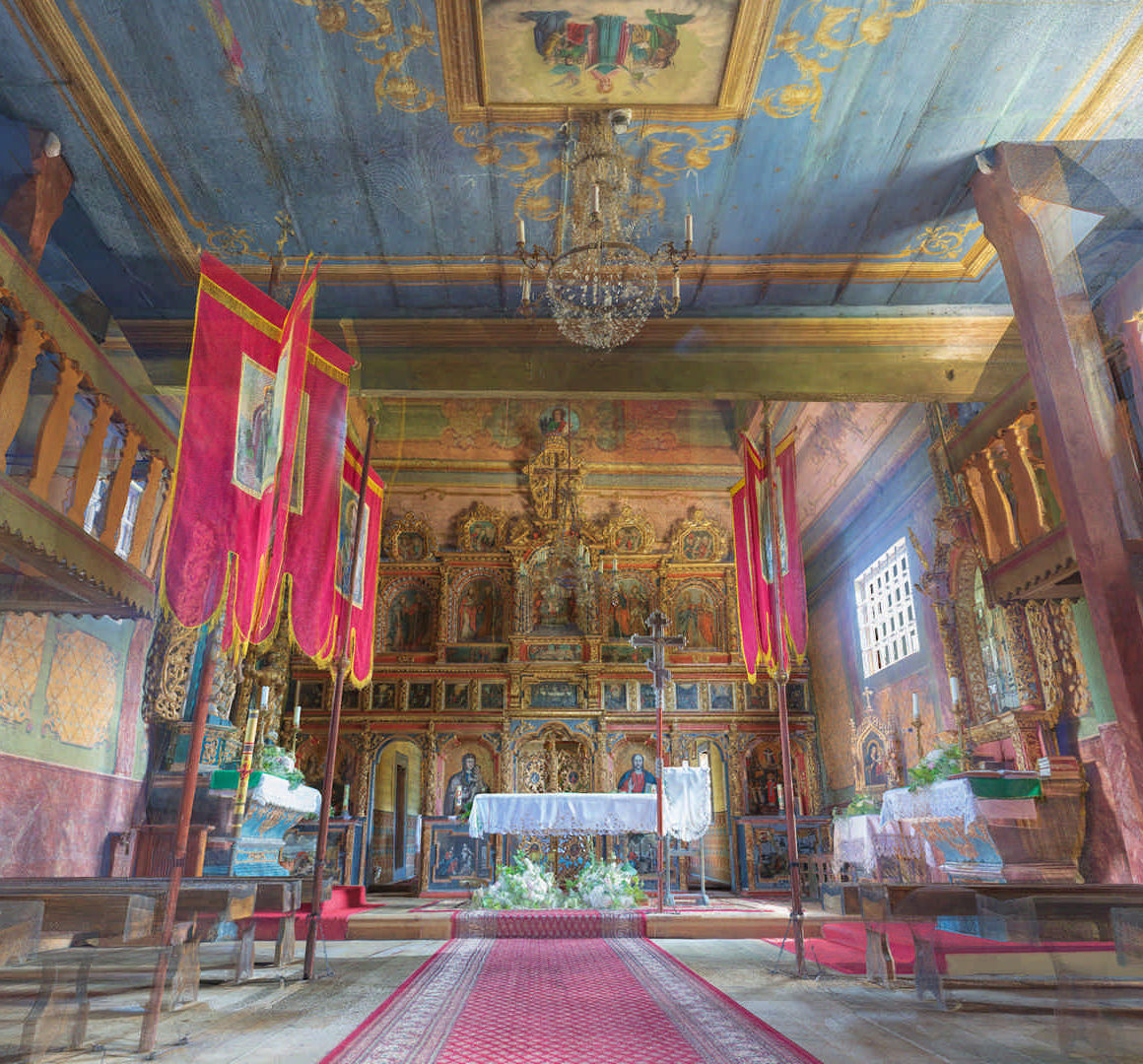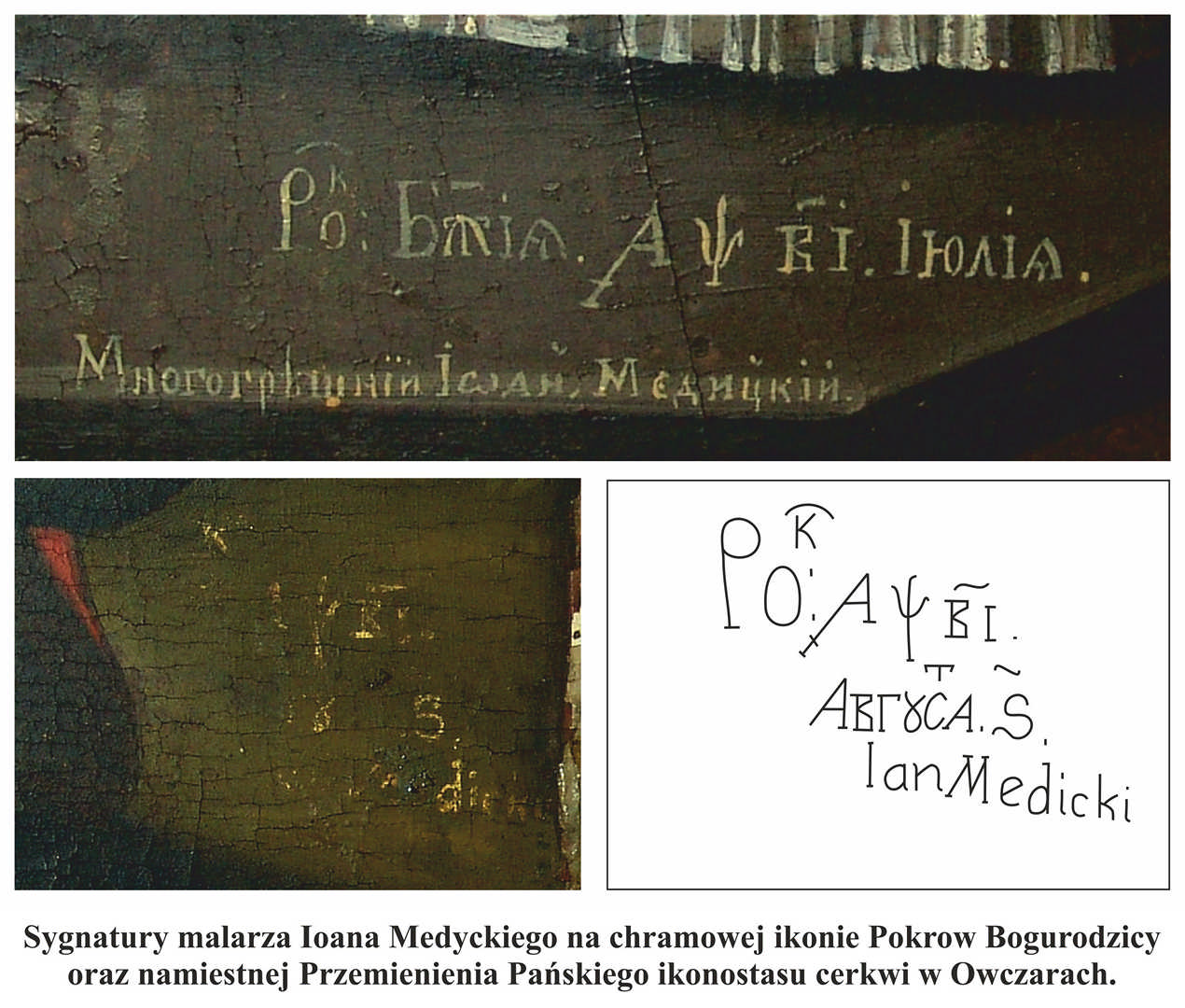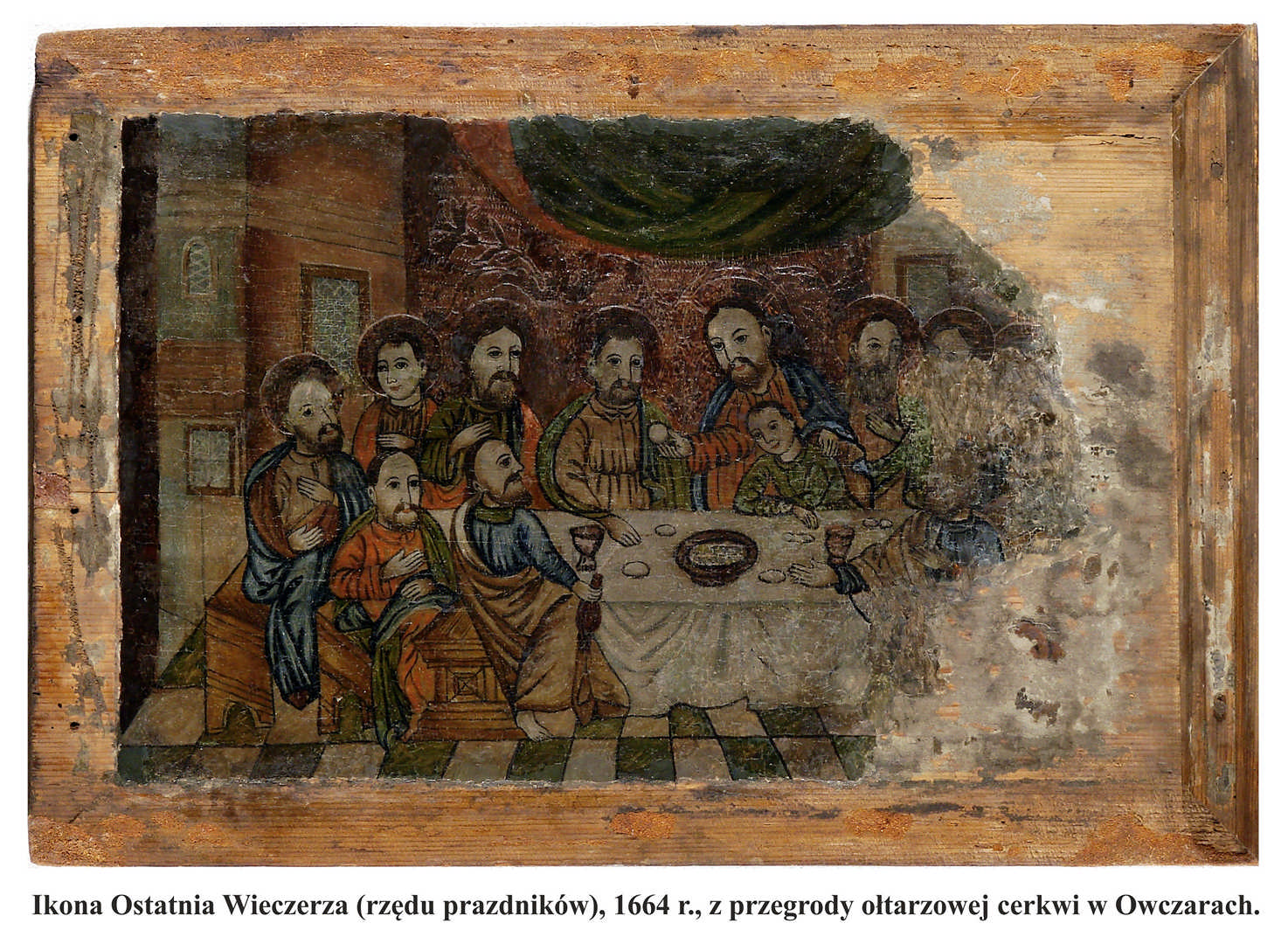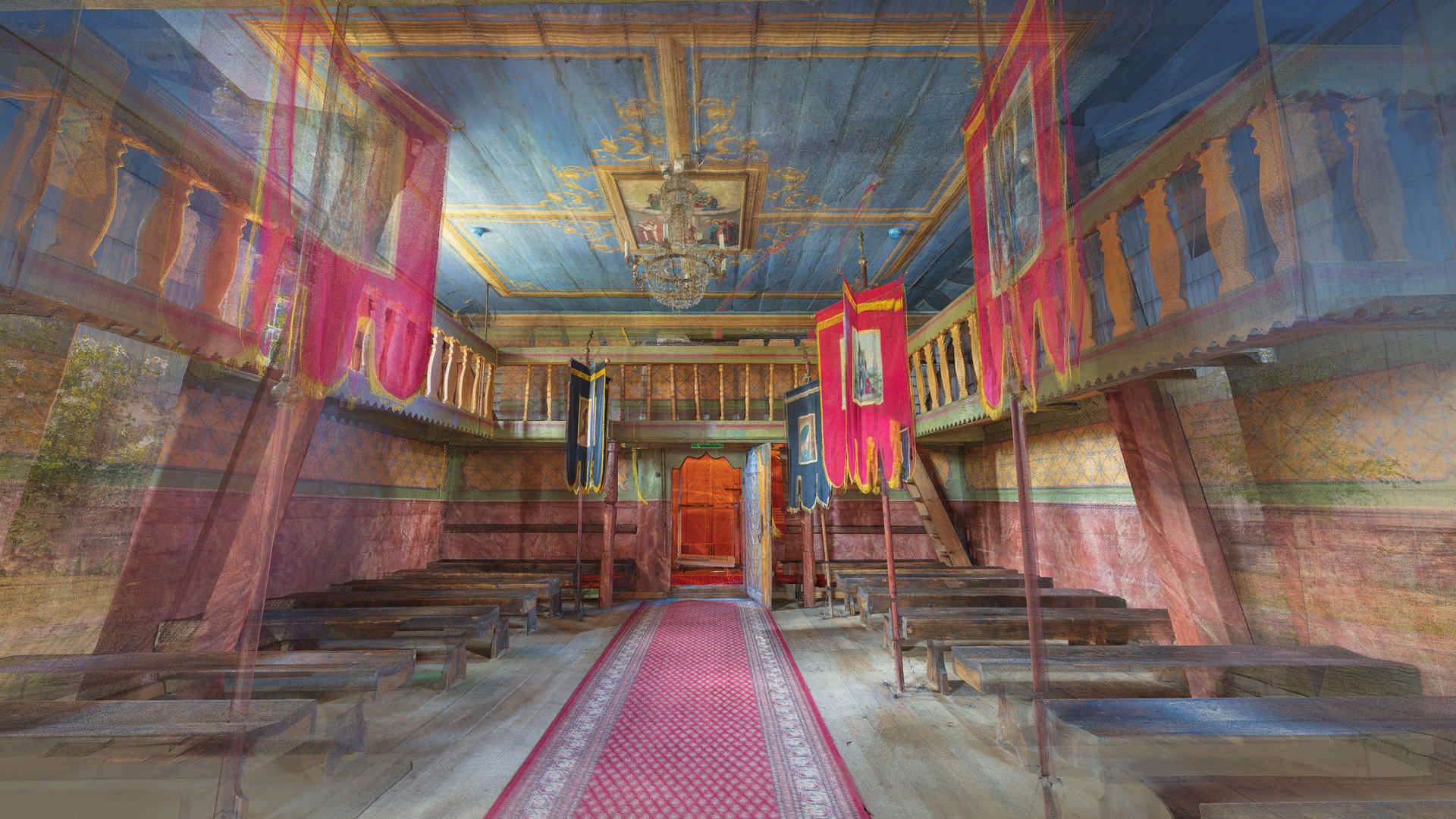The Church of Pokrov, or the Intercession of the Theotokos in Owczary
The building was erected in 1653. It is made of larch wood. It is one of the oldest West-Lemko churches. The spherical domes of its towers are covered with metal. The roof and the walls are protected by shingles.
The matroneum, nave, and sanctuary were built on a square plan. On the northern side, there are only two rectangular windows. One window in the wall of the nave and another very small one in the sanctuary. One window was put in its eastern wall. On the southern side, daylight comes in through four windows. They are much bigger than those on the northern side. The roofs over the nave and the presbytery are two-tiered.
The upper part of the portal decorating the entrance to the nave was curved in a streamlined shape of leaves. Above the edge, there is an engraved date when the construction was completed and the abbreviation of the Latin words Anno Domini, or ‘the year of the Lord’ 1653.
The forged cross at the top of the highest tower has two crossbars. The crosses over the nave and presbytery have one crossbeam, which is proof of the multiculturalism and ecumenism of the modern temple. It holds church services in two religious rites – it is both a Greek Catholic parish church and an affiliate church of the Roman Catholic parish in Sękowa. The small church building is surrounded by a small wall. In front of the main entrance, there is a stone bell tower with a gate in its lower part.
The length of the entire building – 20.5 m
The height of the tower above the matroneum – 21 m
The height of the tower above the nave – 17 m
The height of the tower above the sanctuary – 13 m
The width of the matroneum – approx. 7 m
The width of the nave – approx. 7 m
The width of the sanctuary – 4.5 m
Owczary. Iconostasis.
An iconostasis is a partition made of icons. It has the form of a wooden wall. It separates the sanctuary from the nave. It is a typical element of the furnishings of Eastern Church temples, or Greek Catholic and Orthodox churches. It is made of wood. In addition, an iconostasis has two or three doors.
The extremely valuable iconostasis in the Greek Catholic church in Owczary was created in the years 1712-1756. Ioan Medycki made the Sovereign Icons and the decoration of the bottom part of the iconostasis. He also painted the images on the Royal Doors and the icons of Great Feasts. The other rows of icons were created in 1756 by an unknown painter.
The iconostasis is 7 meters wide and 5.5 meters high. It consists of 38 icons arranged in four horizontal rows, which is a characteristic feature of Greek Catholic religious buildings in the Low Beskids. The iconostasis in Owczary has a red background and numerous, elaborately gilded decorations on its frame. They take the form of a bunch of grapes with leaves and shoots. The icons are dominated by red, blue, and gold.
Each row of icons has its own name and shows different content related to the beliefs of the faith. The lowest row contains the four largest images, the so-called sovereign icons. They have a rectangular shape, with a rounded upper edge. They stand on platforms, the so-called predellas, also decorated with paintings. Apart from the icons, the row of sovereign icons contains three passages to the presbytery. In the middle, there are the Royal Doors, and on the sides – the Deacons’ Doors.
The first one from the left is the icon showing the Transfiguration. It provided the basis for painting the scene of the Good Samaritan. He is leaning mercifully over the wounded man. To the right of the icon, there are the Deacons’ Doors with a semicircular finial. This opening has no door leaf. This is where the priest or the person who assists him during the service walks to the presbytery. To the right of the Doors, we have the second icon of the row. Against a golden background, the Theotokos is holding little Jesus in her arms. He is bowing his head to put his cheek against her face. His right hand is embracing his mother’s neck and his left one is resting on her breast. This type of depiction is known as the Eleusa in the Eastern Church and means ‘tenderness’ or ‘showing love’ in Greek. The base under the icon is decorated with the scene of ‘Jesus in the House of Martha and Mary’. Further to the right, in the center of the iconostasis, there are the magnificent Royal Gates, serving as the passage for the priest holding the service. It is the widest door opening. The doors are gilded and double-leaf. They are the shape of the symbolic Jesse Tree. The middle beam is a trunk. The door wings are decorated with intricate vine branches and leaves. The doors are open-work, which means they have numerous clearances. Three leaves were painted among the leaves on each wing. They depict the scene of the Annunciation of the Theotokos and the four Evangelists. The frame of the Royal Doors is also decorated with some small paintings. They are images of dignitaries of the Eastern Church. The bearded men are wearing episcopal hats and long robes, and holding crosiers.
To the right of the Royal Doors, there is the third sovereign icon. We see a gentle gaze of Christ Pantocrator against a golden background. His brown hair is flowing down over his arms. His fair face is surrounded by a short beard of the same color. The figure of the Savior, shown to his thighs, is covered with a red robe and a blue coat. In his left hand, Christ is holding an open book, while raising the right one in the gesture of blessing. The thumb, forefinger, and middle finger are upright, the other two are slightly bent. This icon was the basis for painting the Gospel scene of Jesus and the Samaritan Woman at the Well.
Further to the right, there is the other Deacons’ Door. To its right – the icon of the patronal saint. It shows the saint to which the temple is dedicated. The one in Owczary is the Orthodox church of the Intercession of the Theotokos, which was symbolically depicted on the icon of the Theotokos (Pokrov). The word pokrov means a protective veil. In the upper part, in the heavens, we can see a figure of the Mother of God surrounded by golden rays. She is wearing a blue coat and a veil. Mary is holding a white and red ribbon. From both sides, she is accompanied by angels and a group of saints: apostles, John the Baptist, Saint Andrew, and Epiphanius. At the bottom of the painting, there is another group of people. In the center, there is a figure of Romanos the Melodist, a famous author of psalms dedicated to the Mother of God. He is wearing a red coat. To his right and left, there are church dignitaries and lay rulers in magnificent cloaks. The basis of the icon is decorated with a painting showing a scene from the Old Testament: Jacob’s Dream.
The second row of the iconostasis, with the icons of Great Feasts, is composed of much smaller square paintings. They depict the most important holidays in the liturgical year. The Church Slavonic word for holidays is prazdniki, which is also the name for these icons. There are 13 Icons of Great Feasts in total. The largest one is located above the Royal Doors – it is the Last Supper. To its right and left, there are six images arranged symmetrically. From the left, they depict the following scenes: the Entrance of the Theotokos into the Temple, Christmas, Epiphany or the Baptism of Christ, the Presentation (or Meeting) of Christ in the Temple, the Annunciation, Entry into Jerusalem, the Resurrection, the Ascension of Christ, Pentecost, the Transfiguration, the Dormition of the Theotokos, and the Nativity of the Theotokos.
The third row of the iconostasis is the Deesis group. The name comes from the Greek word meaning: ‘intercession’, ‘prayer’ or ‘intercessory prayer’. The row consists of 7 quite large icons. They have the same shape as the sovereign icons. In the center, we can see a figure of Christ in Glory, seated on a throne, wearing magnificent robes and a coat. His head is decorated with a crown. In his left hand, he is holding an open book, and his right hand is raised in the gesture of blessing. There are three more icons on both sides of the central one, each with two standing apostles. They are holding their attributes in their hands. They are turned towards Christ. Each of the three central icons in this row have a narrow, horizontal image underneath. They show scenes of Passion, i.e. those related to the Passion of Jesus: the Myrrhbearers, the Burial of Jesus, and Women at the Tomb.
The highest, fourth, row of icons was intended for Old Testament Prophets and Patriarchs. It consists of six icons in the form of octagons. Each of them shows two men with serious looks on their faces. They are holding long scrolls filled with writing. The central part of the fourth row is crowned with a cross with the image of Jesus. It is an Orthodox cross with three horizontal beams (the top and the bottom ones – short, and the middle one – longer).
The church in Owczary currently serves as a temple for two denominations. Since 1998, both Roman and Greek Catholic parishes have coexisted here.
Video:
Panotour:
Panotour – The Church of Pokrov, or the Intercession of the Theotokos in Owczary

